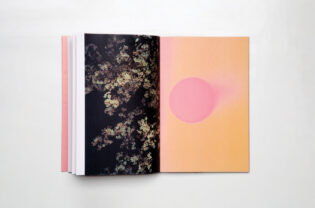Kristin Sweetland. Adventures In Sweetland
Kristin Sweetland’s debuting photography exhibition focuses on a series of manipulated, digitized self-portraits. Set in various, extreme Canadian landscapes, both industrial and rural, Adventures in Sweetland features her self-portrait as a kind of interactive element, engaging and sometimes disrupting the scene. She can be witnessed venturing into sprawling wastes of un-trod rifts of snow above the Arctic Circle in the Northwest Territories in End of the Road, her figure the only motile, dense, black upright in the white, frozen scene. Similarly, like an ironic comment on inevitable change, her form manifests as the solitary, human participant amid the stunning detail that composes a mountain of stony rubble in Brick Mountain (2014). Self-portraits poised on the coastlines of both shores or engulfed amid the looming detritus of abandoned industrial landscapes, adrift in the prairies or couched within the Eastern Canadian breadbasket, furnish the significance of what is essentially the impassioned, serial document of an artist’s love affair with, and shifting ideations around, the sometimes gentle, sometimes threatening land of her birth. The necessarily Romantic view in these representations, of an inspirited patria drenched in the unmistakable aura that inevitably attends perceptions of the sublime, endows her photographs with a numinous, fairytale aura; archetypes vie with specificity, the universal with the personal and particular, and meaning is rendered somewhere in between.
A full-time touring musician, performance artist and writer, Sweetland has performed in urban centres and out-of-the-way locales across Canada. Through the visual documents entailed in Adventures in Sweetland, the myriad moods and tonal ranges of a rich, emotional landscape are reflected, the keys to an inner ‘otherworld’ that only occasionally, fully interfaces with quotidian Canada (and then only in the deepest, mythical wildernesses of town or country). In all these images, the artist’s self-portrait is the only human element in the natural or industrial setting. The figure’s gesture or movement gives the real cues as to how we are to read the colors, formal elements, tonal registers and other messages of the visual text. Sweetland, both behind and in front of the lens, composing then inhabiting and animating the scene like some fey genii loci or antic, elemental spirit, is like the impresario in a magic show. Directing our attention to harmonies, ironies or disjuncts in the setting that might otherwise escape our attention, she focalizes what is immanent and eternal in both the subject and observer of the photographic moment. Rural and urban settings offer up their mythical potentials equally in Sweetland’s otherworldly perspectives. In some cases, the less natural/more industrial the subject, the more potential for some, wild, subversive insistence on ‘beauty’ (or its tweaked perception) is seen to be percolating through the composition.
In The Coldest Day of the Year (2014), dark tram tracks in illuminated snow mirror bright-lit tram-lines coursing through a dark sky. Reflecting each other’s curving trajectories, the aerial and terrestrial tracks sandwich a sort of optimized, liminal, transformative space between them. Sweetland’s ubiquitous, lone upright, once again the only mobile figural form, demarks and comments upon their reciprocal, curvilinear shapes. The figure’s gesture is one of transience and determination, pacing across the inscribed, frozen slush, and emphasizes the trams’ seemingly alert, nocturnal arrest. Parked with their running lights still blazing, the tram cars are somehow reminiscent of a snow-bound, prairie herd of buffalo — standing stock still yet watchful, waiting it out in a blizzard. Through Sweetland’s lens, the human figure interpolated upon the scene, busily occupied with the affairs of civilization of which the trams are, themselves, the artifacts, somehow makes the city transportation car park seem more wild. Like a mythical, industrial wilderness as viewed by a pantheist, its visual elements appear to pulse with animus and readiness.
Perched upon a metal landing, high upon the ruin of an abandoned industrial tower, the figural element seems peripheral in Do Not Enter (2014). Like punctuation (perhaps an apostrophe), it serves as anthropomorphic emphasis for themes of brooding presences and the possibilities of unhappy ghosts, the undead discoursing through concrete and steel on topics related to wasted enterprise. The dual-toned image shifts between the grayish taupe of the abandoned buildings in the picture, to the chromatic, Prussian blue of the storm darkened sky. The narrative embedded among the elements of this picture is a cautionary tale. There is a sense of threat or warning, of emblematic memento mori or vanitas allegories. Like the ‘Lightening-struck Tower’ of the Tarot, the pictured structure seems precariously poised upon the brink of an extinction event, and the position of the lofty, perched figure even more so. The readiness of seemingly solid but uninhabited, ‘de-souled’ structures to crumble and fall suggests itself through the meteorological instability of the sky, portrayed as some sort of harbinger or auger. Whether the imminent event is one of doom, or of apocalyptic transformation and rebirth, the image’s semiotic range doesn’t specify. The picture seems to ask its audience: “What are our chances, do you think?”
Leaving the viewer to delve among intrinsic hope, intuitive knowledge, and/or conditioned pessimism, Sweetland’s visual narratives resist a ready deconstruction. Much like those presented to the otherworldly traveler at the entrances and exits of the storied fairy hill, the riddles they pose do possess one, specific motive, however. They serve the cause — impassioned, extreme and borne quite flagrantly upon the artist’s sleeve — for a re-invigorated perception of earthly immanence. Answering the timeless query, asked of all those who would enter the Otherworld in search of the value and meaning of their quest (“Whom does the Grail serve?”), Sweetland’s layered photographic texts serve, and document, the inspirited land.
KRISTIN SWEETLAND PHOTOGRAPHIC SELF-PORTRAITS IN THE NORTH AMERICAN LANDSCAPE
The Fleishman Gallery, Toronto
February 28 — April 4, 2015






